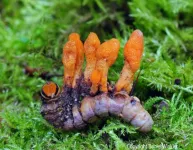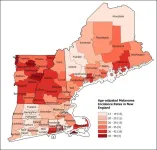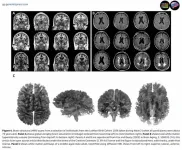(Press-News.org) Why is human culture — the shared body of knowledge passed down across generations — so much more powerful than animal cultures?
“What’s special about our species?” is a question scientists have wrestled with for centuries, and now a scientist at Arizona State University has a new hypothesis that could change the way we perceive ourselves, and the world around us.
“Ten years ago it was basically accepted that it was the ability of human culture to accumulate and evolve that made us special, but new discoveries about animal behavior are challenging these ideas and forcing us to rethink what makes our cultures, and us as a species, unique” said evolutionary anthropologist Thomas Morgan in a new research paper published this week in Nature Human Behavior.
Morgan is a research scientist with the Institute of Human Origins and associate professor with the School of Human Evolution and Social Change.
Just as humans pass on knowledge to our children, when a new queen leafcutter ant hatches, she collects a little mouthful of her mother’s fungus and takes it with her to start a new colony. This has been happening for so long — millions of years — that the fungus within these colonies is genetically different from the wild fungus outside of the colonies.
Similar to how human languages change, new data shows that humpback whale songs evolve, spread between groups and become more complex over time. Like humans, chimpanzees learn to use tools and we now have evidence that they have been doing so for thousands, perhaps millions, of years. Even locusts use complex evolving systems to adapt to local conditions, relying on epigenetic changes – how factors like age and environment can change gene activity without altering DNA sequence – to quickly evolve between calm and green or swarming and yellow-and-black forms based on overpopulation.
These discoveries, along with others, have shown that not only do animals have culture, but there are also examples of accumulation in their culture, something that for a long time was believed to be uniquely human.
“It used to be thought that other species just didn’t have culture,” said Morgan. “And now we know that lots of other species do. Then it was thought that only human cultures accumulate or evolve over time. But now we know animal cultures can do this too. So, if animals do have evolving cultures, then what’s special about human culture that differentiates us from other animals?”
Open-endedness
Morgan and Stanford University Professor Marcus Feldman address this question in their new paper, “Human culture is uniquely open-ended not uniquely cumulative,” published in Nature Human Behaviour.
They present a new hypothesis: that we humans dominate and are so special because of “open-endedness,” – our ability to communicate and understand an infinite number of possibilities in life.
“The way that animals think about what they’re doing constrains the way that their cultures can evolve,” said Morgan. “One way might be that they can’t imagine elaborate sequences very easily, or they can’t imagine subgoals.”
“For example, when I’m making my boys’ breakfast in the morning, it’s a nested, multistep process. First, I need to get the bowls and pots and other equipment. Then I need to put the ingredients in the pot and start cooking, all in the right amounts and order. Then I need to cook it, stirring and monitoring temperature until it reaches the right consistency, and then I need to serve it up,” he said.
“Each of these steps is a subgoal, and these subgoals have steps within them that I need to execute in the right order, so this whole thing is an elaborate procedure.”
When it comes to the limit of this system, human brains just keep going; we are able to build and retain sequences of instructions that are deeply complicated and this allows us to perform a near infinite set of behaviors – this is open-endedness.
Beyond culture
While other scientists have compared human and animal cultures before, Morgan and Feldman’s research is unusual because it also compares animal examples of epigenetic inheritance and parental effects. The leafcutter ants is an example of a parental effect and the locust an example of cumulative epigenetic inheritance.
While both epigenetic inheritance and parental effects are stable and accumulate in non-human species, they eventually stop developing, explains Morgan. “Just like animal cultures, there are constraints that these systems run-up against and that halt their evolution.”
“I think the key question is what is special about human culture, and we tried to answer that by comparing human cultures with animal cultures, with epigenetics, and with parental effects – as many evolving systems as we can think of. And in the end we concluded that the special thing about human culture is its open-endedness. It can accumulate but then it never has to stop, it just keeps going.”
END
What makes human culture unique?
ASU evolutionary anthropologist presents innovative idea about why we are dominating the world over other animals
2024-11-07
ELSE PRESS RELEASES FROM THIS DATE:
Researchers discover dozens of new genes associated with disc herniations
2024-11-07
Lumbar disc herniation is one of the most common structural changes in the lower back and the most common cause of radiating pain, or sciatica, in the leg.
Hereditary risk factors for disc herniations were investigated in a recently published international study led by a University of Oulu research group, utilising data from FinnGen, the Estonian Biobank, and the UK Biobank. The study analyzed the genetic and health data of 829,699 participants.
The study found 41 novel regions of the genome that modify the disease risk for disc herniations, in addition ...
Research shows caterpillar fungus can slow down growth of cancer cells
2024-11-07
New research into a chemical produced by a caterpillar fungus that has shown promise as a possible cancer treatment has revealed how it interacts with genes to interrupt cell growth signals. The discovery is an important step towards developing new drugs for the treatment of the disease.
The research into a chemical produced by a caterpillar fungus has revealed how it may work as a cancer treatment. It interrupts the cell growth signals that are overactive in cancer, an approach that could be less damaging to healthy ...
Tanning bed access and usage is driving higher rates of melanoma in specific regions
2024-11-07
Philadelphia, November 7, 2024 – Melanoma accounts for only 1% of skin cancers in the United States but results in the largest number of skin cancer deaths. Investigators evaluated the potential link between the availability and use of tanning beds and the rising rates of melanoma in New England. They found compelling evidence linking tanning bed usage to increased melanoma risk. Their spatial epidemiologic study in the Journal of Investigative Dermatology, published by Elsevier, provides critical insights to inform public health strategies and reduce melanoma incidence.
The incidence of melanoma in the US has been increasing ...
Mitochondrial dysfunction research transforms mental health: Dr. Ana Andreazza's vision
2024-11-07
Toronto, Canada, 7 November 2024 – From a curious young scientist investigating her grandfather's family wine to a leading expert in mitochondrial health and mental illness, Dr. Ana Cristina Andreazza's journey exemplifies the power of personal motivation in driving scientific innovation. As founder and Scientific Director of the Mitochondrial Innovation Initiative (Mito2i), Dr. Andreazza is revolutionizing our understanding of the connection between cellular energy production and mental health.
In an illuminating Genomic Press Interview, published in Brain Medicine on November 7, 2024, ...
Dr. Nora Volkow shares insights on addiction science and harm reduction in Genomic Press interview
2024-11-07
Bethesda, Maryland, USA, 7 November 2024 – Dr. Nora Volkow's mission to revolutionize addiction treatment began with a deeply personal observation: watching how excessive substance use could profoundly alter a person’s behavior while simultaneously triggering social rejection by others. As the first woman and Hispanic Director of the National Institutes of Health’s National Institute on Drug Abuse (NIDA), Dr. Volkow has dedicated her career to investigating how drugs affect the human brain and how these disruptions contribute to the behavioral/emotional ...
25-year study reveals key factors in healthy brain aging and cognitive performance
2024-11-07
Edinburgh, Scotland, 7 November 2024 – A groundbreaking 25-year research program has unveiled key insights into how our brains age and what factors influence cognitive performance throughout life. The findings, published on 7 November 2024 in Genomic Psychiatry, draw from the Lothian Birth Cohorts (LBC) studies, which uniquely tracked participants' cognitive abilities from childhood through their eighth decade of life.
Professor Ian Deary and Dr. Simon Cox from the University of Edinburgh present remarkable discoveries that challenge conventional wisdom about brain aging. Their research ...
First clinical trial reveals promise of psilocybin treatment for anorexia nervosa
2024-11-07
San Diego, California, 7 November 2024 – In a groundbreaking exploration of psychedelic medicine's potential for treating one of psychiatry's most challenging conditions, researchers at University of California, San Diego (UCSD) provided an analysis and further details of a trial published in Nature Medicine (https://pmc.ncbi.nlm.nih.gov/articles/PMC10427429/) that had shown how psilocybin therapy affects individuals with anorexia nervosa. In the new peer-reviewed Emerging Topic article in Psychedelics ...
Fabrication of 4-inch wafer-scale heterostructure via PECVD drives AI semiconductor performance innovation!
2024-11-07
As artificial intelligence (AI) technology advances, the demand for higher-performing semiconductors is rapidly growing. The development of new materials and innovative structures to achieve high-performance semiconductors has become crucial. For the first time globally, a 4-inch heterostructure fabrication technology using plasma-enhanced chemical vapor deposition (PECVD) has been developed. This breakthrough enables the production of low-power, high-performance semiconductors, surpassing the capabilities of traditional silicon-based technology.
The research team led by Senior Researcher Hyeong-U Kim of the Semiconductor Manufacturing Research Center of the ...
Plastic device aids robot-assisted heart surgery
2024-11-07
Robot-assisted heart surgery usually requires an assistant at the operating table to help the surgeon insert the robot arm through a small incision. The assistant has to constantly make sure the surgeon has enough room to operate via the robot arm. For greater independence on the surgeon’s side, an Osaka Metropolitan University-led group has developed a device that can secure the surgical field.
Graduate School of Medicine Professor Toshihiko Shibata and Associate Professor Yosuke Takahashi worked with colleagues and small and ...
UVM scientists find space-for-time substitutions exaggerate urban bird–habitat ecological relationships
2024-11-07
As bird populations dwindle across the globe, a new study from University of Vermont researchers suggests some species may be more flexible to habitat changes than previously understood, creating new opportunities for supporting populations through city planting efforts. The team’s findings were published in the Journal of Animal Ecology today.
While studies have found bird populations are on the decline—Canada and the United States have lost nearly three billion birds over the last half century—measuring ...
LAST 30 PRESS RELEASES:
An ‘illuminating’ design sheds light on cholesterol
Who is more likely to get long COVID?
Study showcases resilience and rapid growth of “living rocks”
Naval Research Lab diver earns Office of Naval Research 2025 Sailor of the Year
New Mayo-led study establishes practical definition for rapidly progressive dementia
Fossil fuel industry’s “climate false solutions” reinforce its power and aggravate environmental injustice
Researchers reveal bias in a widely used measure of algorithm performance
Alcohol causes cancer. A study from IOCB Prague confirms damage to DNA and shows how cells defend against it
Hidden viruses in wastewater treatment may shape public health risks, study finds
Unlock the power of nature: how biomass can transform climate mitigation
Biochar reshapes hidden soil microbes that capture carbon dioxide in farmland
Reducing saturated fat intake shows mortality benefit, but only in high-risk individuals
Manta rays create mobile ecosystems, study finds
Study: Mixed results in using lipoic acid to treat progressive multiple sclerosis
Norbert Holtkamp appointed director of Fermi National Accelerator Laboratory
New agentic AI platform accelerates advanced optics design
Biologists discover neurons use physical signals — not electricity — to stabilize communication
Researchers discover that a hormone can access the brain by hitchhiking
University of Oklahoma researcher awarded funding to pursue AI-powered material design
Exploring how the visual system recovers following injury
Support for parents with infants at pediatric check-ups leads to better reading and math skills in elementary school
Kids’ behavioral health is a growing share of family health costs
Day & night: Cancer disrupts the brain’s natural rhythm
COVID-19 vaccination significantly reduces risk to pregnant women and baby
The role of vaccination in maternal and perinatal outcomes associated with COVID-19 in pregnancy
Mayo Clinic smartwatch system helps parents shorten and defuse children's severe tantrums early
Behavioral health spending spikes to 40% of all children’s health expenditures, nearly doubling in a decade
Digital cognitive behavioral treatment for generalized anxiety disorder
Expenditures for pediatric behavioral health care over time and estimated family financial burden
Air conditioning in nursing homes and mortality during extreme heat
[Press-News.org] What makes human culture unique?ASU evolutionary anthropologist presents innovative idea about why we are dominating the world over other animals







